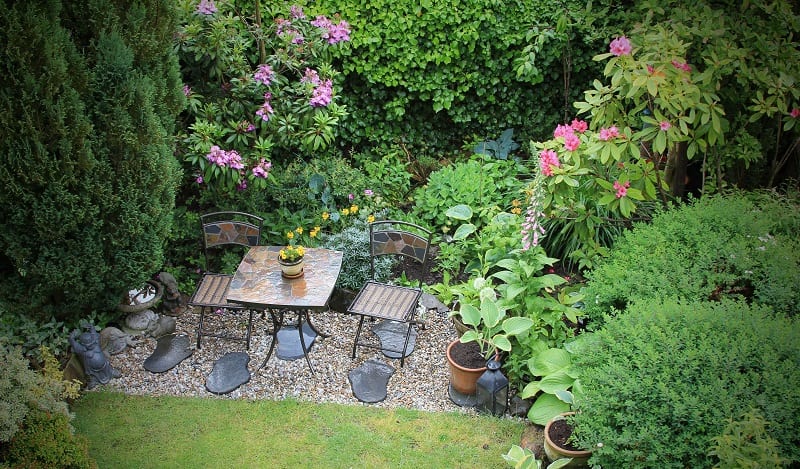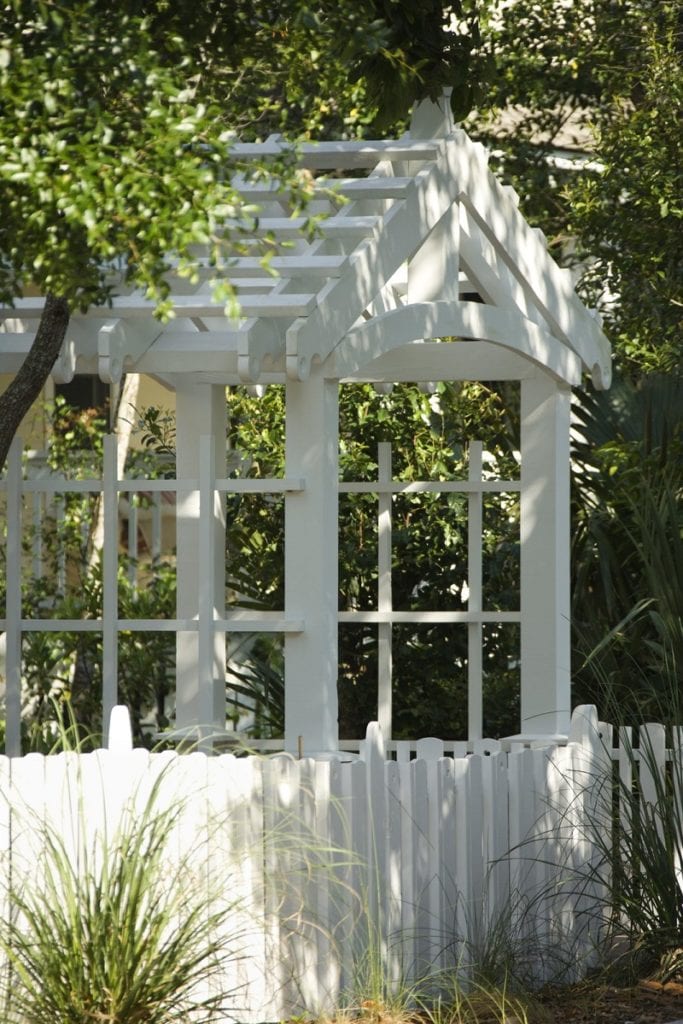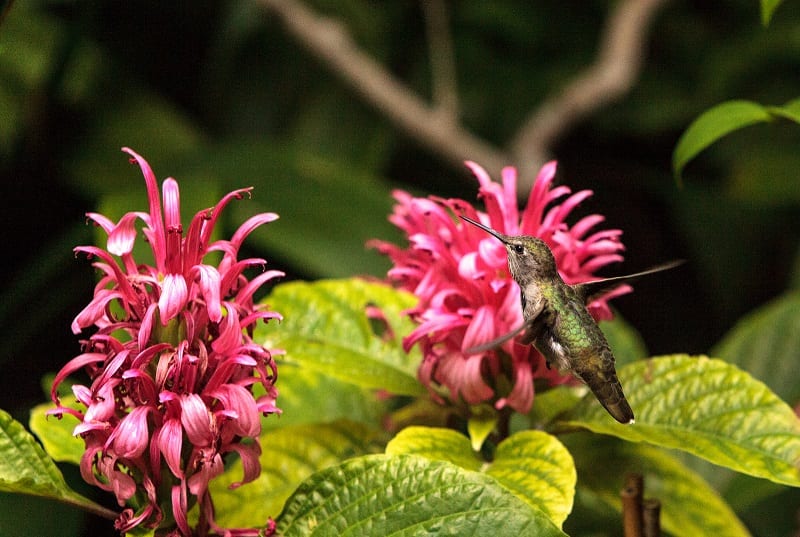Last Updated on May 30, 2024 by teamobn

These days, everyone laments the loss of privacy in our lives. But we seem to have forgotten an old but still powerful tool for rebuilding it: the creation of secret gardens.
These are hidden places – clandestine squares of emerald and purple, oracles of startling yellow and red, tucked into the thick of the urban sprawl.

Ideally, they are invisible – and inaccessible – to all but those whose back doors open onto its deep, cozy green glory.
Creating Your Own Secret Garden
Contents
Of course, secret gardens can also be communal. Here you can have children’s birthday parties, cocktail parties, egg hunts, trick-or-treating, or visits from Santa.
For children, a secret garden can be a safe private playground. For parents, it could be a godsend. For harried professionals, secret gardens can provide a quiet sanctuary at the end of a long day.
Secret gardens work a certain kind of magic on people. You can create your own unique magic, too, right in your backyard – with a little effort and imagination.
You don’t have to spend too much. You can start with what you already have.
Below are a few tips on creating your very own secret garden.
1. Choose a spot.
Find Your Garden’s Enclosure
Start by identifying a secluded planting spot. An ideal location is often a corner that naturally feels enclosed, providing an immediate sense of privacy and boundary. This could be a corner of your yard that’s less visible from the street or shielded from neighbors’ views.
Utilize Natural and Artificial Barriers
If no natural enclosure exists, create one. Look for a group or row of existing trees or shrubs that can be enhanced to form a secluded area. These natural elements not only block sightlines but also blend seamlessly into the landscape, enhancing the secret aspect of your garden.
Incorporate Walls and Fences
Walls and fences can serve as effective barriers, providing privacy and structure to your garden. They don’t need to surround the space completely; even a wall or fence off to one side can significantly increase the sense of seclusion. These structures are also ideal for climbing plants, adding greenery and depth.
Add Arbors and Trellises
For a touch of charm and to enhance the entrance or specific sections of your garden, consider installing an arbor draped with flowering vines. Arbors act as beautiful gateways that not only define the entry to your secret garden but also support climbing plants like roses, clematis, or jasmine. Similarly, trellises or sections of wooden fencing can be strategically placed to partition spaces within the garden, supporting climbing plants and adding vertical interest.
Choosing the right spot for your secret garden is about balancing the natural characteristics of your yard with enhancements that align with your vision for a private, enchanting retreat.

2. Create an entryway
Design a Captivating Entrance
The gateway to your secret garden should make a statement. A well-defined entryway, typically featuring an arbor with a gate, serves as the perfect introduction to your hidden retreat. An arbor not only supports climbing plants but also frames the entrance, creating an inviting pathway that draws visitors into the garden. According to Wanda Simone from From House to Home, an arbor gives an entrance that “looks and feels special,” transforming a simple walkway into an enchanting passageway.
Use Plantings to Enhance Seasonal Beauty
To keep the entryway engaging throughout the year, consider planting seasonal flowers and plants. Start with spring bulbs such as tulips and daffodils, which provide bright bursts of early color. For summer, fill pots and hanging baskets with vibrant annuals like petunias and geraniums. In the fall, mums add a splash of autumnal color, while evergreens can maintain greenery and structure during the winter months. These plantings not only refresh the look of your secret garden’s entryway seasonally but also ensure it remains a focal point all year round.
Flexible Design Elements
Incorporate movable containers to easily adapt the appearance of your entryway. Containers allow for flexibility in planting and can be rearranged or updated as seasons change or as your preferences evolve. This adaptability is especially useful in maintaining the allure and mystery of the secret garden, keeping the entryway dynamic and inviting with each visit.
By carefully crafting the entry to your secret garden, you create an initial impression of wonder and exclusivity. This entrance sets the stage for the tranquility and beauty that lies within, beckoning visitors to step into a world crafted just for them.

3. Create a destination.
Choose a Focal Point
Every secret garden needs a destination—a place that draws the eye and invites you to stay awhile. This could be as simple as a striking sculpture, a water feature, or a beautiful, flowering trellis. The centerpiece should reflect your personal style and the overall theme of the garden, whether it’s a classical statue, a rustic fountain, or a modern art piece.
Provide Comfortable Seating
Comfort is key when creating your garden’s destination spot. A comfortable chair or bench, ideally suited to the outdoor environment, is essential. Choose furniture that complements the garden’s design and can withstand the elements. For added luxury, include plush cushions and throws that can be easily removed in inclement weather.
Create a Multi-Functional Space
Consider the different functions your destination spot might serve. It could be equipped with a beautiful table for enjoying meals outdoors, doubling as a place for leisurely breakfasts, al fresco lunches, or peaceful evening dinners under the stars. Alternatively, it could be a serene spot for meditation with a simple yet elegant bench, placed in a quiet corner of the garden.
Enhance with Accessories
To make your destination spot truly relaxing, add elements that enhance comfort and enjoyment. A side table to hold books and beverages, outdoor rugs to define the space and add warmth, and decorative outdoor lighting such as lanterns or string lights can make the area more inviting. Plant surrounds that offer privacy and beauty, like fragrant jasmine or climbing roses, can also enhance the sensory experience of your destination spot.

4. Provide shade.
Utilize Existing Natural Shade
If your garden already has mature trees, you’re in an advantageous position. Trees not only provide ample shade but also contribute to the atmosphere and ecological balance of your garden. Position your seating areas under the canopy of these trees to maximize the natural cooling effects and aesthetic appeal.
Introduce Man-Made Shade Structures
For gardens lacking natural shade, incorporating man-made structures is a must. Options like pergolas covered with climbing plants, such as wisteria or grapevines, offer not only shade but also visual and olfactory pleasure. Gazebos and pavilions are other sturdy options that provide extensive shade and can become central features of your garden.
Consider Shade Sails and Umbrellas
Shade sails and large garden umbrellas are versatile and cost-effective solutions for creating shade. These can be strategically placed to shield the most sun-exposed parts of your garden. Their portability allows for adjustments based on the sun’s position and your usage needs throughout the day.
Plant Additional Trees and Shrubs
Planting new trees is a long-term investment that will enhance the beauty and functionality of your garden. Deciduous trees, which provide shade in the summer and allow sunlight in the winter, are particularly valuable. Fast-growing varieties like maples or poplars can offer quicker relief from the sun. Shrubs and tall grasses can also provide lower levels of shade and enhance privacy.
Use Climbing Plants on Trellises
Trellises with climbing plants not only enhance the beauty of your garden but also provide necessary shade. They are ideal for smaller spaces where planting large trees isn’t feasible. Climbing roses, ivy, and honeysuckle are excellent for creating a green, living screen that cools the air around them.
Incorporating these shading techniques ensures that your secret garden remains a blissful sanctuary, even during the warmest days, allowing you to enjoy the outdoors without the discomfort of excessive heat.

5. Choose your plants.
Utilize Existing Natural Shade
If there are mature trees in your garden already, you are lucky. Trees give your garden enough of shade and also add to its ambiance and ecological balance. To get the best of both worlds—natural cooling and visual appeal—place your seating sections beneath these trees’ canopy.
Introduce Man-Made Shade Structures
Manmade buildings must be included into gardens without natural shade. Shade and visual and aromatic enjoyment can be enjoyed from pergolas covered with climbing plants like grapevines or wisteria. Other strong choices that can become focal points of your garden and offer a lot of shade are gazebos and pavilions.
Consider Shade Sails and Umbrellas
Shade sails and large garden umbrellas are versatile and cost-effective solutions for creating shade. These can be strategically placed to shield the most sun-exposed parts of your garden. Their portability allows for adjustments based on the sun’s position and your usage needs throughout the day.
Use Climbing Plants on Trellises
Trellises with climbing plants not only enhance the beauty of your garden but also provide necessary shade. They are ideal for smaller spaces where planting large trees isn’t feasible. Climbing roses, ivy, and honeysuckle are excellent for creating a green, living screen that cools the air around them.
Incorporating these shading techniques ensures that your secret garden remains a blissful sanctuary, even during the warmest days, allowing you to enjoy the outdoors without the discomfort of excessive heat.

6. Invite birds and pollinators.
Choose Plants That Attract Wildlife
For your secret garden to draw in hummingbirds, butterflies, and bees, plant selection is essential. Drawn especially well to these pollinators are red salvia, coral vine, trumpet honeysuckle, columbines, fuchsias, and bee balm. Hummingbirds and butterflies find great nectar sources in these plants, which also brighten and animate your landscape.
Provide Water Sources
In every garden that wants to draw in animals, a birdbath or a small pond are musts. In urban and suburban environments in particular, these water features give birds and pollinators someplace to drink and wash, which is essential for their survival. For wildlife to find the water appealing and safe, make sure it is clean and replenished often.
Create Habitats for Nesting
Encouraging birds to stay in your secret garden involves providing them with nesting opportunities. Plant dense shrubs, vines, and climbing plants that offer shelter and nesting spots. Adding a flowering fruit tree or shrub like bayberries, dogwood, cherries, and crabapples not only provides food but also potential nesting sites. These trees and shrubs offer dual benefits—beautiful blooms for your garden and nourishment for visiting wildlife.
Offer a Variety of Food Sources
To keep birds and pollinators returning, ensure a steady supply of food throughout the year. Bayberries, dogwood, cherries, and crabapples are excellent choices for providing fruits that many bird species enjoy. For pollinators, ensure that your garden has a range of flowering plants that bloom at different times of the year, providing continuous nourishment across the seasons.
By implementing these strategies, your secret garden will become a bustling hub of nature’s activity. Inviting birds and pollinators not only enriches the environment but also brings a sense of life and dynamism to your secret garden, making it a place of discovery and delight every day.

Your Own Urban Paradise
The language we superimpose on gardens, flowers, and plants is something we all understand – not because it represents something tangible, but because it is an important part of our well-being.
Urban living can – at times – lapse into a dull, grey, unhealthy monotony. Those of us who have lived in cities long enough knows this. But a secret urban paradise is surprisingly feasible. All that is required is a modest and relatively simple effort.
Have you already created your own secret garden? We’d love to hear about your experiences.








